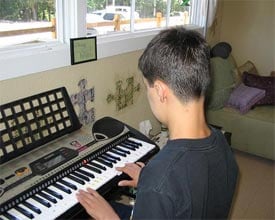Yamaha Portable Keyboards Are Top Tools at The Purple Piano

People with developmental, behavioral and physical disabilities are among the success stories of The Purple Piano, where the teaching tools of choice are Yamaha portable keyboards. |
Those students include people with developmental, behavioral and physical disabilities – an audience familiar to Sherman, who holds a degree in the Psychology of Music and Creativity from Lesley College and currently works at Bradley Hospital in East Providence, where she has taught a therapeutic music program for the developmentally disabled for seven years. For the past two years, Sherman and her business partner Arthur “Skip” Bradley have operated a unique special needs music program at The Purple Piano – a program which has grown out of her private practice – and which has brought some of her techniques and tools into a new setting. Some of those favorite teaching tools include new and vintage Yamaha portable keyboards, namely, the models from the PSR and EZ lines – the PSR273, PSR275, PSR175, EZ-20 and EZ-30.
“Although I used Yamaha portable keyboards long before my association with the hospital,” she says, “using them with that population has been the most affirming, and solidified my confidence in both using and recommending them. At the hospital, I started with older, used keyboards – which is a good thing – as some of the patients can be violent. Keyboards got knocked around, banged on, and went down stairs, yet they still managed to work. Not only were they tough, but they provided a good alternative to carrying around a Rhodes or a suitcase piano. I had started teaching in my home, but once we came to this space and the word got out, we attracted a wide range of special needs students, including people with autism, cerebral palsy and traumatic brain injuries. When someone comes in and asks me about what their child, or in some cases, adults – people who have had strokes, for example – can use, I can recommend these keyboards for them.”
Since opening in 2003, The Purple Piano has offered a variety of music and art instruction for approximately 300 students, age three through adult, and a staff of 27 teachers. The 5,000-square-foot space is set up to be a funky home environment of sorts, with each room giving the feel of taking a music lesson in a living room, with couches, kitchen tables and chairs, bicycles on the ceiling, and a selection of consignment art and antiques. Sherman says that she favors the PSR and EZ units because their features – follow lights, soft touch keys, auto accompaniment, talkback and self-correction – seem almost custom-made for non-verbal and tactile-sensitive users.
“I’m not sure how much the developers of these products anticipated what would be done with them, beyond being educational tools for ‘normal’ folks,” she adds. “Even with very little instruction, they’re very motivating for the students.”
The success stories include a 17-year-old girl who had suffered brain trauma, speech loss and right-side paralysis as the result of an accident. “She’s in a wheelchair and non-verbal,” Sherman explains. “Two years ago, she could only use her left hand and two fingers on her right hand, although her mental capacity was still there. We put her on one of the EZ units, and gradually started taking away some of the cues (the speaking and the follow lights); she can now read music and uses all ten fingers. Somewhere, it all just came together with very little direction. Her physical therapist, her father and I have talked about how incredible it’s been, rebuilding and relearning to use other areas of the brain. Music is now a big part of her life.
“I also have a young boy with cerebral palsy who’s in a wheelchair,” she continues. “His hands were always moving, and I worked with him around the follow lights on the EZ30. I’d say, ‘make nine of those lights on the keyboard go out in a row.’ He would really concentrate and was constantly motivated. Now he loves to play Sting’s ‘Englishman in New York.’”
“We also just had an autistic girl who came in recently. “When I put her on one of the PSRs, she heard a few notes of ‘Dance of the Sugarplum Fairy’ from The Nutcracker and was able to play the full song. You could tell she knew it because she knew exactly how long to hold the notes.”
Sherman obtains instruments from a number of local dealers in the Providence area, and has future plans to add a keyboard lab, expanded guitar instruction, and classes in music theory and basic recording techniques. With primarily word-of-mouth advertising, The Purple Piano has attracted students from up to one hour away.
“Some people come with the mindset that they need to buy an acoustic piano right away,” she adds. “What we do is loan them a keyboard in the beginning, the logic being that even if they eventually got an acoustic piano someday, they would still have the portability of the keyboard. I’ve seen first-hand the versatility of these products, and the healing power of music. That’s what I talk about when people come in.”
For more information, write Yamaha Corporation of America, Pro Audio & Combo Division, Portable Keyboards, P.O. Box 6600, Buena Park, CA 90622; telephone (714) 522-9011; or e-mail infostation@yamaha.com.
 |
| © 2010 Yamaha Corporation of America. All rights reserved. |
